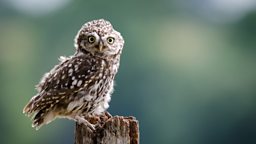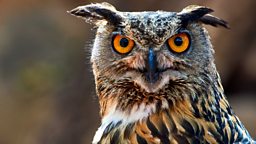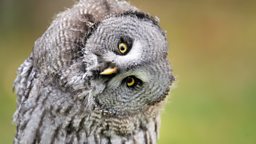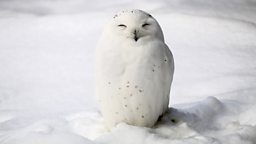Seven things you didn’t know about owls
Our captivation with owls is nothing new, with the oldest known depiction of the bird dating back 36,000 years.
In Natural Histories, Brett Westwood investigates the contradictions as owls are seen as lovable cuddly creatures and wicked associates of witches and the darks.
Here are some fascinating facts to celebrate our favourite nocturnal bird, the wise old owl.

1. A female owl is normally around 25% larger than her male counterpart. One theory behind the size discrepancy is that the males are more agile in order to efficiently catch their prey. The lightest species of owl is the Elf Owl. Around six inches tall when fully grown, it is the size of a sparrow and weighs less than a golf ball! The largest owl in the world is the Eurasian Eagle-Owl, with females growing to a length of around 75cm. It has distinctive tufts of feathers on its head, which are often mistaken for ears.
2. In English folklore, owls have long been considered a harbinger of doom. An owl flying past a window, or heard overhead, was thought to warn of an impending death in the household. In ‘Macbeth’, Shakespeare calls the owl the ‘fatal bellman’, because bells were often rung to announce an execution.


3. Owls can rotate their heads an incredible 270 degrees in either direction. They have 14 vertebrae in their necks (twice as many as humans), which allows them to rotate without causing damage to blood vessels or cutting off blood flow to their brains.
4. There are around 200 different species of owl and the bird is found in all regions of the world except Antarctica. The Snowy Owl, native to the snow-clad Arctic tundra, has white feathers to blend in against the snow and plumage spread all over the body (including its toes) to help it stay warm when the air temperature drops to as low as −50 °C. It also hunts during the day so it can survive the Arctic summer, when the days are so long that there are few or no hours of darkness.

5. Owls have extremely acute hearing, developed because they largely hunt at night. The Great Grey Owl can locate its rodent prey, hidden beneath 2 feet of snow, from a distance of half a mile away.
6. In Western culture, owls are synonymous with knowledge and wisdom. This is largely considered to be a result of Greek mythology: Athena, the goddess of wisdom, is consistently portrayed accompanied by a Little Owl. In India, an owl is considered dim-witted rather than wise. In fact, ‘oolu’ – the Hindi word for owl – is also used to describe a foolish person.
7. The Chauvet Caves of southern France have the oldest known depiction of an owl in the world, estimated to be 36,000 years old. The bird is drawn from behind, with its head swiveled backwards 180 degrees to meet the gaze of people walking towards it.


-
![]()
Natural Histories: Owl
Brett Westwood investigates the biology and culture of owls.
-
![]()
How a Northern Forest will increase the UK's tree coverage
Around 13% of the UK is covered with trees - but that figure is set to get a boost.
-
![]()
Lost for words: 14 expressions that have vanished
Terms and expressions that have vanished or been banished from your dictionary.
-
![]()
How dry stone walls stay upright
We generally pay little attention to the skills involved in building and maintaining them.




